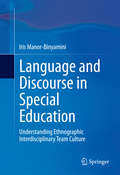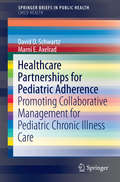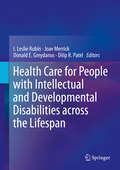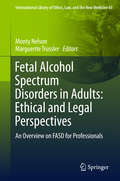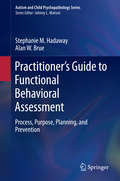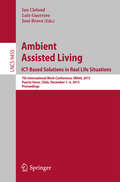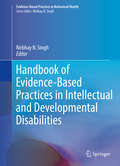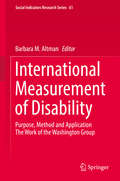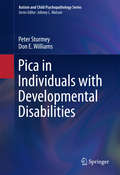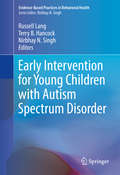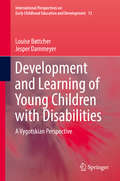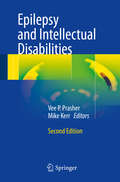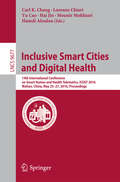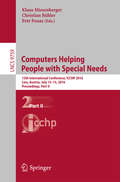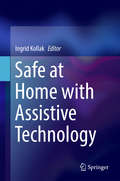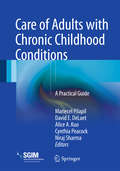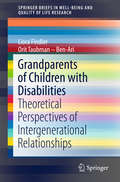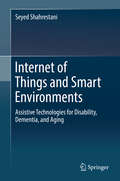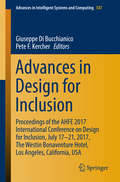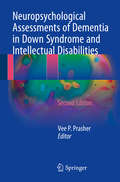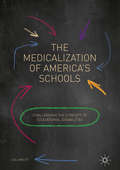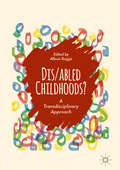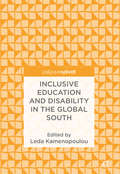- Table View
- List View
Language and Discourse in Special Education
by Iris Manor-BinyaminiThis book examines the words and discourse as well as their meaning and impact on the everyday culture of a multidisciplinary team at a school for students with mental disabilities. The book examines the organizational, social, professional, and emotional experiences of team members from such disciplines as child and school psychology, special education, therapy (e. g. , occupational, speech), social work, and pediatric medicine within a special education school. It explores the ways in which team members describe and interpret the day-to-day requirements of working effectively in a special education school, using their own language and discourse from a subjective point of view. In addition, the book analyzes and interprets the influence of language and discourse on the outlook, behavior patterns, and the coping of team members working in the school with the students, among themselves as a team, and with the difficulties and dilemmas that concern them as well the solutions that they themselves introduce for all these issues. This book, with its focus on the unique and complex work environment of the multidisciplinary special education team, is essential reading for researchers, professionals, and graduate students in child and school psychology, therapeutic disciplines (e. g. , occupational, speech), social work, pediatric medicine, and allied mental health and medical fields.
Healthcare Partnerships for Pediatric Adherence
by David D. Schwartz Marni E. AxelradThis timely professional reference and educational resource applies current concepts of pediatric adherence to medical treatment to create a model for a family-centered, collaborative approach to managing chronic illness. At its core are the latest findings on adherence: the factors that encourage it, the barriers that derail it, and the most effective interventions for its improvement. The book's developmental lens highlights how adherence waxes and wanes across different stages of childhood and adolescence, and specialized chapters analyze social realities exacerbating adherence problems. And its end product is a framework for how patients, parents/caregivers, and providers can work together effectively for improved adherence and optimum outcomes. Included in the coverage: The scope and impact of nonadherence. Poverty, stress, and chronic illness management. Racial/ethnic health disparities and adherence. Reconsidering the idea of self-management. · Screening for nonadherence in pediatric patients. · A comprehensive behavioral health system for identifying and treating nonadherence. Healthcare Partnerships for Pediatric Adherence offers relevant contemporary perspective for pediatricians looking for new ways to reduce treatment failure, improve support to patients and their families, and promote patient involvement in their own care.
Health Care for People with Intellectual and Developmental Disabilities across the Lifespan
by Donald E. Greydanus Dilip R. Patel Joav Merrick I. Leslie RubinThis book provides a broad overview of quality health care for people with intellectual and developmental disabilities (IDD). It focuses on providing the reader a practical approach to dealing with the health and well-being of people with IDD in general terms as well as in dealing with specific conditions. In addition, it offers the reader a perspective from many different points of view in the health care delivery system as well as in different parts of the world. This is the 3rd , and much expanded edition, of a text that was first published in 1989 (Lea and Fibiger). The second edition was published in 2006 (Paul Brookes) and has been used as a formal required text in training programs for physicians, nurses and nurse practitioners as well as by administrators who are responsible for programs serving people with IDD. This book is considered the "Bible" in the field of health care for people with IDD since 1989 when the first edition came out.
Fetal Alcohol Spectrum Disorders in Adults: Ethical and Legal Perspectives
by Monty Nelson Marguerite TrusslerThis book discusses and provides insight on the legal and ethical dilemmas of managing those with Fetal Alcohol Spectrum Disorder (FASD). This book provides a clear perspective for those clinicians and legal professionals who are working with those with this disorder, and correspondingly increases their understanding when arranging effective supports for this population. Historically, the primary focus on FASD has been on children. However, this is a lifelong disorder and the implications of this disorder become even more prominent and complex in adulthood. Those with this condition can struggle with impulsiveness, and a host of cognitive difficulties. This correspondingly impacts their independence and employability, and produces an elevated risk for homelessness and other residential issues, involvement in substance use, being exploited, development of behavioural issues, and subsequent legal difficulties. Their cognitive difficulties result in challenges for legal systems around the world to understand their issues, and to design appropriate remedial strategies, recommendations for treatments and supports, and even for understanding the failure of many of these individuals to be able to change their behaviours effectively. This produces various legal and ethical dilemmas, which are discussed in detail in this volume by 28 authors from Europe, New Zealand and North America. These include discussions regarding the rights of the unborn child, the alcohol industry's duty to warn, whether small amounts of alcohol during pregnancy can be condoned, and even the current use of involuntary hospitalization for addicted mothers. Other chapters discuss the need for training on FASD for front line officers, use of lies during interrogation of those with FASD, medical and legal interventions for offenders with FASD, access to diagnostic services and follow-up supports, and whether FASD can be considered a mitigating factor for sentencing. Furthermore, caregivers also provide their stories regarding the daily dilemmas that are faced in raising those with FASD.
Practitioner's Guide to Functional Behavioral Assessment
by Alan W. Brue Stephanie M. HadawayThis practical guide introduces functional behavioral assessment as a critical tool in planning interventions to reduce disruptive and other problematic behaviors. The book offers proven methods and strategies as a four-stage protocol in an easy-to-follow format with checklists, Q&A sections, applications, and an extended case example including an assessment report and intervention plan. Step-by-step instructions are delivered in an accessible teaching style, making all phases of assessment equally manageable. And although functional behavioral assessment is typically associated with schoolchildren, this material is also useful for working with adults in residential and community settings. The Guide gives readers: The basics of functional behavioral assessment. Guidance in preparing for conducting a functional behavioral assessment. An overview of assessment methods: formal and informal measures, interview, and observation. A framework for translating assessment data into an appropriate intervention plan. In-depth understanding of the role of prevention in behavioral intervention. A kit of questionnaires, worksheets, and other ready-to-use resources. Practitioner's Guide to Functional Behavioral Assessment is an essential resource for clinicians and related professionals as well as researchers and graduate students in school and clinical child psychology; behavior therapy; assessment, testing and evaluation; special education; and educational psychology.
Ambient Assisted Living. ICT-based Solutions in Real Life Situations: 7th International Work-Conference, IWAAL 2015, Puerto Varas, Chile, December 1-4, 2015, Proceedings (Lecture Notes in Computer Science #9455)
by José Bravo Ian Cleland Luis GuerreroThis book constitutes the refereed proceedings of the 7th International Work-Conference on Ambient Assisted Living, IWAAL 2015, held in Puerto Varas, Chile, in December 2015. The 20 full papers presented with 7 short papers were carefully reviewed and selected from 31 submissions. The focus of the papers is on following topics: ambient assisted living for tele-care and tele-rehabilitation; ambient assisted living environments; behaviour analysis and activity recognition; sensing for health and wellbeing; human interaction and perspectives in ambient assisted living solutions.
Handbook of Evidence-Based Practices in Intellectual and Developmental Disabilities
by Nirbhay N. SinghThis handbook presents a diverse range of effective treatment approaches for individuals with intellectual and developmental disabilities (IDD). Its triple focus on key concepts, treatment and training modalities, and evidence-based interventions for challenging behaviors of individuals with IDD provides a solid foundation for effective treatment strategies, theory-to-implementation issues, and the philosophical and moral aspects of care. Expert contributions advocate for changes in treating individuals with intellectual and developmental disabilities by emphasizing caregiver support as well as respecting and encouraging client autonomy, self-determination, and choice. With its quality-of-life approach, the handbook details practices that are person-centered and supportive as well as therapeutically sound. Topics featured in the handbook include: Functional and preference assessments for clinical decision making. Treatment modalities from cognitive behavioral therapy and pharmacotherapy to mindfulness, telehealth, and assistive technologies. Self-determination and choice as well as community living skills. Quality-of-life issues for individuals with IDD. Early intensive behavior interventions for autism spectrum disorder. Skills training for parents of children with IDD as well as staff training in positive behavior support. Evidence-based interventions for a wide range of challenging behaviors and issues. The Handbook of Evidence-Based Practices in Intellectual and Developmental Disabilities is a must-have resource for researchers, clinicians, scientist-practitioners, and graduate students in clinical psychology, social work, behavior therapy, and rehabilitation.
International Measurement of Disability
by Barbara M. AltmanThis volume provides an informed review of the accomplishments of the Washington Group on Disability Statistics (WG) in the provision of international data and statistics on disability. It does so within the context of the UN Convention on the Rights of Persons with Disabilities. The volume includes a description of the development and testing of a short set of questions for Censuses, now used in approximately 29 countries and recommended in the U. N. 's Principles and Recommendations for Population and Housing Censuses: The 2020 Round, which includes disability as a core topic to be collected in censuses. It discusses the experiences of several countries on the use of the WG questions and how this has impacted on national agendas in the area of disability. It follows the development and testing of an extended set of questions for use in national surveys other than censuses and examines the challenges of translation and the importance of generating comparable question sets in different languages and within different cultures. It studies the examination of cognitive testing techniques in a variety of countries, and presents the results of the first round of censuses in 2010 in countries using the six question set. The volume includes discussions of the new development of question modules on a broad range of child disability and functioning, and the environmental contexts of participation that are part of the current work of the WG. In addition, it contains a reflection on the use of the WG's functionality approach to identifying disabilities by humanitarian agencies to identify disabilities in populations of displaced persons. A thoughtful conclusion addresses what the development of cross-nationally comparable data can mean for the improvement of circumstances for all persons with disabilities.
Pica in Individuals with Developmental Disabilities
by Peter Sturmey Don E. WilliamsThis book provides a comprehensive overview of the clinical phenomenon of pica. It focuses specifically on the disorder as it presents in children, adolescents, and adults with autism spectrum disorder (ASD) and intellectual disabilities (ID). Initial chapters introduce current theories and definitions, followed by a more detailed examination of how developmental disabilities complicate diagnosis and intervention. The volume describes evidence-based and clinically sound approaches to the treatment and prevention of pica in school and adult clinical settings, ranging from behavioral treatment to function-based interventions. In addition, it discusses common diagnostic, client, and provider issues that result in pica remaining undetected among individuals with ASD and ID. Featured topics include: Definition of pica in accessible terms, differentiating between various forms of the disorder. Issues and practical methods of prevention and treatment of pica in developmentally disabled persons. Functional and behavioral assessment methods for pica in individuals with ASD and ID. A range of effective behavioral and nonbehavioral treatments for pica. Illustrative cases and service delivery challenges. Areas for future research and practice. Pica in Individuals with Developmental Disabilities is an invaluable resource for researchers, clinicians and other professionals, and graduate students in clinical child and school psychology, behavior analysis/therapy, and social work as well as child and adolescent psychiatry, pediatrics, family studies, and special education.
Early Intervention for Young Children with Autism Spectrum Disorder
by Nirbhay N. Singh Russell Lang Terry B. HancockThis book examines early intensive behavioral intervention (EIBI) programs for young children with autism spectrum disorder (ASD). It analyzes current research on early intervention (EI) and explains the importance of accurate, timely detection of ASD in facilitating the use of EI. Chapters address five widely researched EIBI approaches: Discrete Trial Training, Pivotal Response Training, the Early Start Denver Model, Prelinguistic Milieu Teaching, and Enhanced Milieu Teaching. This in-depth study of current EIBI approaches offers a rigorous guide to earlier and more intensive interventions for children with ASD, leading to greater autonomy and improved later life outcomes for individuals. Featured topics include: Parent-implemented interventions and related issues. Evaluations of controversial interventions used with children with ASD. Factors contributing to rising ASD prevalence. Obstacles to obtaining accurate ASD diagnosis in young children. Early Intervention for Young Children with Autism Spectrum Disorder is an essential resource for researchers, clinicians, and graduate students in developmental, clinical child, and school psychology, behavioral therapy/rehabilitation, social work, public health, educational policy and politics, and related psychology and behavioral health fields.
Development and Learning of Young Children with Disabilities
by Louise Boettcher Jesper DammeyerThis book introduces current theories and research on disability, and builds on the premise that disability has to be understood from the dialectical dynamics of biology, psychology, and culture over time. Based on the newest empirical research on children with disabilities, the book overcomes the limitations of the medical and social models of disability by arguing for a dialectical biopsychosocial model. The proposed model builds on Vygotsky's cultural-historical ideas of developmental incongruence, implying that the disability emerges from the misfit between individual abilities and the cultural-historical activity settings in which the child with impairments participates. The book is a theoretical contribution to an updated understanding of disability from a psychological and educational perspective. It focuses on the first years of the life of the child with impairment, and travels through infancy, toddler, preschool and early school age, to track the developmental trajectories of disability through the dialectical processes of cultural, social, individual, and biological processes. It discusses a number of themes that are relevant for the early development and support for children with various types and degrees of disability through the lens of Vygotsky's cultural-historical developmental theories. Some of the themes discussed are inclusion, mental health, communication, aids and family life.
Epilepsy and Intellectual Disabilities
by Vee P. Prasher Mike KerrThis second edition of a successful book provides updated clinical and research knowledge, including information on the licensing of new antiepileptic drugs. All chapters are updated to reflect present accepted practice. New chapters highlighting the importance of the genetic aspects of epilepsy, nonpharmacological treatments, and the impact of epilepsy on families and carers have been added. Ongoing developments in the general population, which will more likely than not become relevant to the intellectually disabled population, are discussed. The impact of epilepsy on the person themselves and their carers is acknowledged, and person-centred treatment programs with a multifaceted team approach are proposed. This book is aimed at physicians and residents in neurology and pediatrics, as well as other practitioners working with this population, such as neuropsychologists. Epilepsy and Intellectual Disabilities, Second Edition is recommended reading for all those caring for this important group of individuals.
Inclusive Smart Cities and Digital Health
by Yu Cao Mounir Mokhtari Hai Jin Carl K. Chang Lorenzo Chiari Hamdi AloulouThis book constitutes the proceedings of the 14th International Conference on Smart Homes and Health Telematics, ICOST 2016, held in Wuhan, China, in May 2016. The 39 regular papers, 5 short papers and 1 poster paper included in this volume were carefully reviewed and selected from 83 submissions. They were organized in topical sections named: smart homes, smart urban spaces and new assistive living space concepts in the smart city; e-health for future smart cities; context awareness and autonomous computing; home networks and residential gateways; middleware support for smart homes and health telematic services; e-health and chronic disease management; e-health technology assessment and impact analysis; tele-assistance and tele-rehabilitation; modeling of physical and conceptual information in intelligent environments; medical big data collection, processing and analysis; human machine interfaces; wearable sensors and continuous health monitoring; social, privacy and security issues; mobile health services; and smart rehabilitation technologies.
Computers Helping People with Special Needs: 15th International Conference, ICCHP 2016, Linz, Austria, July 13-15, 2016, Proceedings, Part II (Lecture Notes in Computer Science #9759)
by Klaus Miesenberger Christian Bühler Petr PenazThe introduction to the 1st International Conference on Computers for Han- cappedPersons(Vienna,1989)byAMinTjoa(UniversityofVienna)andRoland Wagner(UniversityofLinz)?nishedwiththefollowingmissionstatementonthe "Future Direction on Computers for Handicapped Persons": "The di'erent themes show that a lot of problems are solved by the usage of computer technology for helping handicapped persons, for instance for the blind and visually handicapped. A consequence of the discussed themes there are two directions which should be done in the next years. One direction is obvious. The tools must be improved and research and development work should be extended to all groups of handicapped (even if they are numerically not so large as for instancetheblindorvisuallyhandicappedpersons). Ontheothersideinthearea of social implications there is an increasing demand on social science studies on overall computer use among disabled persons. Because sources are in principle missing today about disabled persons work tasks, research in this ?eld must begin by trying to survey this aspect. Particular attention should be paid to the extent and character of computer use among the handicapped in work life. There are a lot of questions, which should be answered during the next years for reaching the aim of rehabilitation. " Fifteen years later the 9th International Conference on Computers Helping People with Special Needs (Paris, 2004) o'ered a comprehensive and deepened view on general awareness,special research and individual applications conce- ing disabled people and their participation in our society.
Disability in the Global South
by Shaun Grech Karen SoldaticThis first-of-its kind volume spans the breadth of disability research and practice specifically focusing on the global South. Established and emerging scholars alongside advocates adopt a critical and interdisciplinary stance to probe, challenge and shift common held social understandings of disability in established discourses, epistemologies and practices, including those in prominent areas such as global health, disability studies and international development. Motivated by decolonizing approaches, contributors carefully weave the lived and embodied experiences of disabled people, families and communities through contextual, cultural, spatial, racial, economic, identity and geopolitical complexities and heterogeneities. Dispatches from Ghana, Lebanon, Sri Lanka, Cambodia, Venezuela among many others spotlight the complex uncertainties of modern geopolitics of coloniality; emergent forms of governance including neoliberal globalization, war and conflicts; the interstices of gender, race, ethnicity, space and religion; structural barriers to redistribution and realization of rights; and processes of disability representation. This handbook examines in rigorous depth, established practices and discourses in disability including those on development, rights, policies and practices, opening a space for critical debate on hegemonic and often unquestioned terrains. Highlights of the coverage include: Critical issues in conceptualizing disability across cultures The challenges of disability statistics. Colonialism and disability Disability and poverty: critical renegotiations Livelihoods and disability: the complexities of labouring in the global South. Intersectional terrains, including migration, race, ethnicity, and customary embodiedness Disability and Religion Violence against disabled women in the global South: working locally, acting globally. Disability-inclusive disaster risk reduction The UNCRPD and critical orientations towards disability rights within various contextual settings Redistribution systems including disability inclusive budgeting, social security regimes and social policy measures Global South-North partnerships: intercultural methodologies in disability research. This much awaited handbook provides students, academics, practitioners and policymakers with an authoritative framework for critical thinking and debate about disability, while pushing theoretical and practical frontiers in unprecedented ways.
Safe at Home with Assistive Technology
by Ingrid KollakThis book describes how assistive technology can help handicapped, elderly and acutely sick people to manage their daily lives better and stay safe in the home. It discusses how safety is understood from an ethical, technical and social perspective, and offers examples of the problems that users, their helpers and professional carers have with assistive technology in everyday situations. The book provides insights from user-centred research and uses photographs to illustrate the main topic: how users and technology can work together to ensure safety. User-focused and combining experience with research, the book will interest users of these kinds of technology, health professionals who might introduce and/or prescribe them, engineers who develop and sell assistive technological gadgets, and architects who build safe homes - as well as researchers and students who work in these fields. It provides an overview of the existing technology, examines ways to test its effectiveness from the point of view of users, health professionals and researchers from different fields (architecture, education, engineering, facility management, medicine, nursing, occupational therapy, rehabilitative medicine, physiotherapy, social science and speech therapy), and lists useful addresses, websites and literature
Care of Adults with Chronic Childhood Conditions: A Practical Guide
by David E. Delaet Mariecel Pilapil Alice A. Kuo Cynthia Peacock Niraj SharmaThis book addresses the unique healthcare needs of adults with chronic childhood illnesses. It presents a model of primary and secondary prevention for emerging adulthood--primary prevention in which all young adults are screened for high-risk behaviors and health needs and secondary prevention in which young adults with chronic childhood conditions are optimized through coordinated care, connections to community resources and social/family support. This book is organized in five parts. Part I provides a detailed overview of the health care transition from pediatrics to adult medicine from both a policy and practice perspective. In Part II, the concept of emerging adulthood as a developmental period is explored and strategies for providing improved comprehensive care for this age group are discussed. Part III reviews specific chronic childhood conditions, such as attention-deficit/hyperactivity disorder, autism, cystic fibrosis, and diabetes mellitus, and offers clinical cases and summary reports that can be used as a quick guides to each condition. In Part IV, additional clinical considerations that are not necessarily condition-specific but are highly relevant to the care of young adults with chronic childhood conditions are examined. Part V describes the socio-legal issues involved in caring for this population. Care of Adults with Chronic Childhood Conditions provides primary care providers with a new framework for the care of young adults and identifies opportunities to influence patient health outcomes over a life trajectory.
Grandparents of Children with Disabilities
by Liora Findler Orit Taubman – Ben-AriThis briefs offers a comprehensive view of the journey of grandparents of children with disabilities by employing a wide range of theoretical approaches such as intergenerational relationships, positive psychology, psychoanalytic views and models of stress. It presents a multidimensional view of grandparents, which begins with the general role of grandparents in the family and the transition to grandparenthood, as a major life event. The briefs moves on to discuss grandparents' roles under unique circumstances such as illness or disability in the family and then deals with perspectives of parents of children with disabilities on the role of grandparents. Finally, it reviews attitudes of professionals toward grandparents and concludes with suggested intervention strategies for working with families on intergenerational relationships.
Bioarchaeology of Impairment and Disability: Theoretical, Ethnohistorical, and Methodological Perspectives (Bioarchaeology and Social Theory)
by Jennifer F. Byrnes Jennifer L. MullerOver the years, impairment has been discussed in bioarchaeology, with some scholars providing carefully contextualized explanations for their causes and consequences. Such investigations typically take a case study approach and focus on the functional aspects of impairments. However, these interpretations are disconnected from disability theory discourse. Other social sciences and the humanities have far surpassed most of anthropology (with the exception of medical anthropology) in their integration of social theories of disability. This volume has three goals: The first goal of this edited volume is to present theoretical and methodological discussions on impairment and disability. The second goal of this volume is to emphasize the necessity of interdisciplinarity in discussions of impairment and disability within bioarchaeology. The third goal of the volume is to present various methodological approaches to quantifying impairment in skeletonized and mummified remains.
Internet of Things and Smart Environments
by Seyed ShahrestaniThis book is focused on the Internet of Things (IoT) services and smart environments that can be of assistance to the elderly and individuals living with dementia or some sensory impairment. The book outlines the requirements of the systems that aim to furnish some digital sensory or cognitive assistance to the individuals and their caregivers. Internet of Things and Smart Environments: Assistive Technologies for Disability, Dementia, and Aging covers the important evolutions of the IoT, the sensors, actuators, wireless communication and pervasive computing systems, and other enabling technologies that power up this megatrend infrastructure. The use of the IoT-based systems in improving the conventional assistive technologies and provisions of ambient assisted living are also covered. The book takes an impartial, and yet holistic, view to providing research insights and inspirations for more development works in the areas related to assistive IoT. It will show the potentials of using normally available interactive devices, like smartphones or smart TVs, which can be supplemented with low-cost gadgets or apps to provide assistive capabilities. It aims to accentuate the need for taking a comprehensive and combinatory view of the comprising topics and approaches that are based on the visions and ideas from all stakeholders. The book will examine these points and considerations to conclude with recommendations for future development works and research directions. This book can be of value to a diverse array of audience. The researchers and developers in healthcare and medicine, aged care and disability services, as well as those working in the IoT-related fields, may find many parts of this book useful and stimulating. It can be of great value to postgraduate and research students working in these areas. It can also be adapted for use in upper-level classroom courses relevant to communication and smart technologies, IoT applications, and assistive technologies. Many parts of the book can be of interest to the elderly and individuals living with a disability, as well as their families and caregivers. From an industry perspective, it can be of interest to software, hardware, and particularly app developers working on the IoT applications, smart homes and environments, and assistive technologies for the elderly and people living with disability or dementia.
Advances in Design for Inclusion: Proceedings of the AHFE 2017 International Conference on Design for Inclusion, July 17–21, 2017, The Westin Bonaventure Hotel, Los Angeles, California, USA (Advances in Intelligent Systems and Computing #587)
by Giuseppe Di Bucchianico Pete F KercherThis book focuses on a range of topics in design, such as universal design, design for all, digital inclusion, universal usability, and accessibility of technologies independently of people s age, economic situation, education, geographic location, culture and language. It especially focuses on accessibility for people with auditory, cognitive, neurological, and visual impairments, ageing populations, and mobility for physical special needs. The book explores some of the overlaps between inclusive design and web accessibility to help managers, designers, developers, policy makers, and researchers optimize their efforts in these overlapping areas. Based on the AHFE 2016 International Conference on Design for Inclusion, held on July 27-31, 2016, in Walt Disney World(r), Florida, USA, this book discusses new design technologies, highlighting various requirements of individuals within a community. Thanks to its multidisciplinary approach, the book represents a useful resource for readers with different kinds of backgrounds and provides them with a timely, practice-oriented guide to design for inclusion. "
Neuropsychological Assessments of Dementia in Down Syndrome and Intellectual Disabilities
by Vee P. PrasherUp to the early 1980s neuropsychological assessments of persons with intellectual disability (ID) usually meant an assessment for developmental delay, of intelligence (intelligence quotient testing) or of level of adaptive behavior. Popular tests included the Stanford-Binet, Wechsler Intelligence Scales, Bayley Scales of Infant Development, the Griffin Mental Developmental Scales, and the Vineland Social Maturity Scale. These were assessments of the "overall" level of ability. Arthur Dalton in New York was one of a few pioneering clinicians who at this time, focused on the development of tests for specific areas of cognition in persons with ID. Following his work, sub- quent researchers, in the latter part of the twentieth century, have proposed and dev- oped a number of measures not only to detect the level of cognitive abilities but also to measure decline; a perquisite to the diagnosis of dementia. At the beginning of the twenty-first century as demonstrated in this book, several neuropsychological measures have been developed to aid the clinical diagnosis of dementia/dementia in Alzheimer's disease (AD). Neuropsychological assessments no longer remain the sole responsibility of psychologists, as psychiatrists, resear- ers, ID nurses, neuroscientists, all now play a part in the development and adm- istration of specific tests.
The Medicalization of America's Schools
by Joel MachtThis book challenges the validity of ADHD, learning disabilities, and dyslexia as meaningful special education "categories" and critically examines the misplaced medical model from which they are derived. The presumption that these disabilities cause school-related problems detracts from identifying factors within the classroom that create and maintain a child's underachievement and disruptive behavior. Moreover, when the disability is finally named, it provides no functional information that translates into effective coping strategies. Macht delves into the misunderstood structure of these disabilities, pointing out that they are not verifiable disabilities but weak constructs that poorly describe each child's uniqueness. Finally, he provides an alternative model based on children's strengths rather than their deficiencies, and presents strategies that advance school-related success.
Dis/abled Childhoods?
by Allison BoggisThis edited collection explores the intersectionality of childhood and disability. Whereas available scholarship tends to concentrate on care-giving, parenting, or supporting and teaching children and young people with special educational needs and disabilities, the contributors to this collection offer an engaging and accessible insight into childhoods that are impacted by disability and impairment. The discussions cut across traditional disciplinary divides and offer critical insights into the key issues that relate to disabled children and young people's lives, encouraging the exploration of both disability and childhoods in their broadest terms. Dis/abled Childhoods? will be of interest to students and scholars across a range of disciplines including Special Educational Needs; Childhood Studies; Disability Studies; Youth Studies; and Health and Social Care.
Inclusive Education and Disability in the Global South
by Leda KamenopoulouThis edited volume examines inclusive education and disability in the global South. Presenting four qualitative research studies conducted in Malaysia, Bhutan, Philippines and Belize, the authors examine the implementation of inclusive education and disabled children’s participation in the education system: contexts on which very little is known. Thus, this book provides a unique opportunity to access rare context-specific information concerning this region of the world; and to reflect on the particular challenges some countries face in the realization of full participation of all children within education. Authored by researchers who are also teaching professionals with experience and understanding of the complexities of the real world, this book reminds us that researchers and policy makers must listen to all voices and perspectives: especially those that have remained silenced and ignored.
